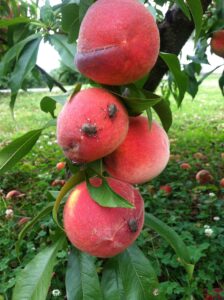Temperature Affects Stink Bugs More Than Any Other Factors

Here is an excellent synoptic piece on the environmental constraints on stink bug populations written by Richard Levine, featured in Entomology Today and available at PLOS one in the research article titled “Contrasting Role of Temperature in Structuring Regional Patterns of Invasive and Native Pestilential Stink Bugs”.

Adult BMSB on late season peach.
By using complex spatial and statistical analyses, entomologists from Maryland, Virginia, and Delaware determined that temperature is the primary driver of stink bug patterns, and they identified differences in thermal tolerances among native and invasive stink bugs.
The researchers conducted a survey of three stink bug pests — the invasive brown marmorated stink bug (BMSB) and two native insects, the green stink bug and the brown stink bug — in soybean fields in Maryland, Virginia, West Virginia, and Delaware. They found that the abundance of BMSB became lower as temperatures increased in June. In fact, no BMSBs were found in fields with average June temperatures that were higher than 23.5º C (74º F).
However, in contrast to the invasive BMSB, the abundance of the native stink bugs increased as temperatures rose.
This study highlights the importance of temperature on the pattern of distribution and abundance of stink bugs. The early developmental stages are particularly vulnerable to high summer temperatures. Photo by Dilip Venugopal.
“This is important for understanding the establishment and growth of BMSB populations that are spreading to other parts of the United States and in Europe,” said Dr. Dilip Venugopal, a current AAAS science and technology policy fellow hosted by the U.S. EPA, and one of the co-authors. “These results can help us predict the pest potential of BMSB and the vulnerability of agricultural systems in various regions, and accordingly target control efforts. For example, the north-central and central regions of the U.S. contain very high soybean acreage, but temperatures from March to June are too low for optimal growth and development of BMSB eggs and early nymphal stages.”
However, people in these colder areas shouldn’t expect to be completely free of the BMSB because some warmer areas will still support them.
“Urbanized areas in these regions could support high abundance of BMSB by acting as ‘heat islands’ because cities tend to be warmer than rural areas,” Dr. Venugopal said. “Similarly, in the southeastern U.S. where warmer temperatures do not support large stink bug populations, BMSB might occur in higher abundance in the western mountains and Piedmont region, where it is cooler than the eastern coastal plains.”
This study is the first comprehensive large-scale survey that quantifies the interactive roles of the environment, resource availability, and distance from the source population on the pattern of distribution and abundance of stink bugs. Previous studies on BMSB examined these factors mostly in isolation.
Additionally, this study clearly identifies the spatial scale at which each of these factors operate, and it is the first to distinguish the roles of environmental and landscape factors on invasive versus native stink bugs.
“This study shows that despite the similarity among BMSB and native stink bugs in terms of their broad host-plant choice and stages of crops they prefer, their environmental and landscape associations are entirely different,” Dr. Venugopal said. “The native stink bugs have a tolerance for higher summer temperatures than BMSB, and that probably explains their broad distribution range in the U.S. However, BMSB is not able to tolerate very high summer temperatures. In pest management programs, similar group of pest species tend to get grouped together for similar strategies for management. Our results show that regional management strategies for stink bugs should incorporate these biological differences.”